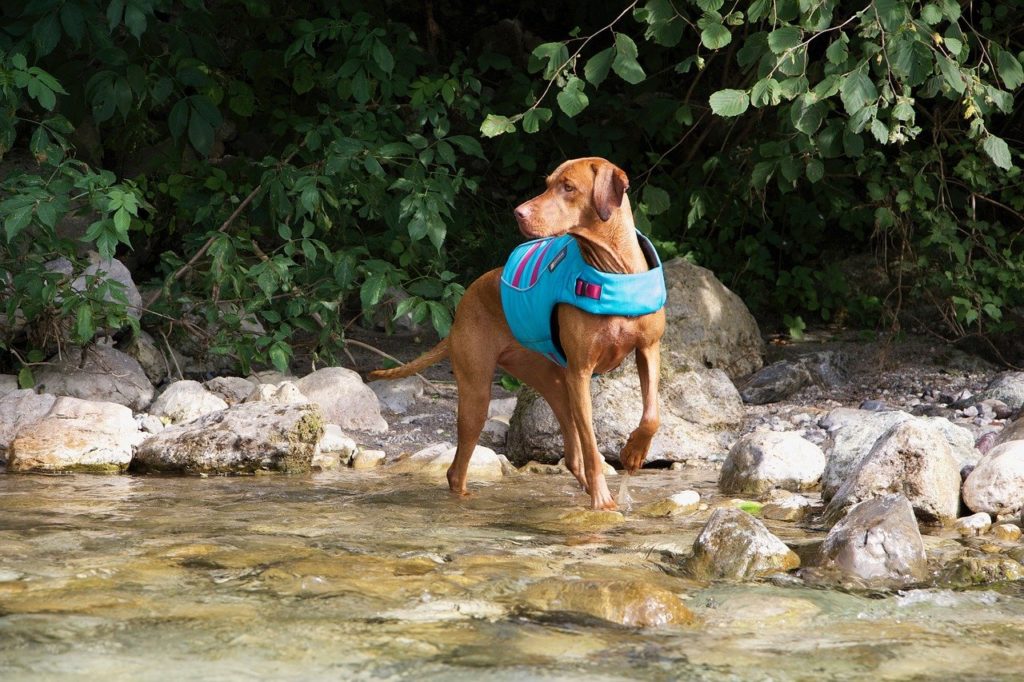No matter where we venture or roam, we like to take our dogs with us. Vacations to the beach, camping trips to the lake, fishing outings on the boat, or even quick dips in the backyard pool, our faithful friends always follow close behind. Of course, you’d never step into the water without knowing how to swim, right? But what about your dog? While our pups have no problem splashing through a sprinkler or wrestling with the hose, deeper water is a different matter. We credit canines with inventing the doggie paddle, but can all dogs swim? As it turns out, there are quite a few exceptions – and some might surprise you!
Dogs and Water
There’s something hypnotic about watching a dog lazily paddle their legs in a careful rhythm through the water. The instinct goes to work as soon as they encounter a large enough body of water. The internet is full of videos of pups paddling away, even when just held above their swimming pools. You can experiment with this yourself (maybe skip it if your dog weighs more than 50 pounds – your back won’t find it amusing). The primal part of their brain kicks in, encouraging them to start the coordinated movements designed to keep them afloat. Which works great – in theory.
Once your dog enters the water, though, it’s a different story. Depending on head shape and size, body conformation, leg length, and even hair length, dogs may or may not swim well – or even at all. Some breeds take to the water without a second thought. Others need a little encouragement. And then there are those dogs who, rather than swim, sink like bricks.

Dogs Who Swim
The natural-born swimmers aren’t difficult to pick out. They have thick, waterproof coats and duck-like webbing between their toes. The breeds started with tasks of retrieving waterfowl for hunters or assisting fishers on boats. Their legs are long and have powerful muscles designed to propel them through the water in that recognizable doggie paddle. Get these canines near so much as a puddle, and they happily dive right in. They make excellent Dock Dogs, diving after a favored toy over and over. And (not surprising) you often see “water” somewhere in their name:
- Golden Retriever
- Irish Water Spaniel
- Labrador Retriever
- Novia Scotia Duck Tolling Retriever
- Portuguese Water Dog
Dogs Who Swim – With Lessons
Then you get to the canines that have the potential to swim – deep down inside. Maybe they lack those defining swimming features of the true swimming dogs, but the doggie paddle knowledge resides in the depths of their brains. But maybe a lake – or even a pond – is too large and intimidating for their size. (Even your backyard pool can seem vast to a Chihuahua) If panic sets in, all of the swimming knowledge in the world won’t matter.
If you have one of the pups, you’ll need to take some time to work with your overwhelmed swimmer to boost their confidence. Consider introducing them to a swimming dog who can show them how much fun water is. Work from kiddie pools up, rewarding every step along the way. If you make the water a less scary place, you’ll find your dog swimming in no time.
Dogs Who CAN’T Swim
Finally, we come to the dogs who struggle to swim. The design of their bodies makes the act of swimming extremely difficult, if not impossible. Brachycephalic breeds, such as Pugs, top the list. The flattening of their faces forces them to tilt their head back to keep their noses and mouths clear of the water. It’s not a comfortable swimming position, and they tire quickly.
Then you have canines with short legs (Dachshunds, anyone?). Those tiny legs need to work twice as hard to keep their bodies afloat – and the struggle may not be enough. Again, you’ll find those kiddos tiring rapidly.
Finally, deep-chested breeds have an awkward distribution of their weight. The top-heavy pattern leaves them (again) working harder to keep their head up. These breeds do better sticking to splashing their feet in the shallows – and even then, you need to keep constant supervision:
- Basset Hound
- Bulldog (These poor dogs sink like stones – they have EVERY negative trait!)
- Boxer
- Dachshund
- Pug

Water Safety
Your dog loves the water, but they aren’t the strongest swimmer. (There ARE Pugs out there who think the pool and ocean are amazing) Or you have a swimmer, but they don’t know their limits. Even the breeds who rush into the pool without a second thought need you to keep a close eye on them. Water presents plenty of hazards for accomplished and novice swimmers alike. Whether you’re starting to teach your dog to swim or heading for an annual trip to the lake, make sure you follow safety guidelines for your dog. The last thing you want is an accident, especially if you’re trying to encourage your dog to swim!
Temperature
You may not mind if the ocean feels a little chilly, but dogs swimming in cold water present several problems. Check the water temperature and add it to the air temperature. If it comes out lower than 100F, it’s TOO COLD for your dog to go swimming. Dogs with short hair coats, in particular, chill easily. Cut the swimming session short and get them warmed up.
When exposed to cold water for a significant length of time, your dog can develop a condition known as rudder tail. Your dog’s tail will droop flat, and they won’t have the ability to lift it or have any strength to wag it. This IS serious, as the muscles and nerves suffer from the cold exposure. A veterinarian can prescribe anti-inflammatory medications to ease the pain, and you’ll need to provide plenty of rest. You can easily prevent rudder tail by checking that water temperature, though.
Over-Hydration?
Water itself is one of the biggest hazards your swimming dog can face. Many dogs enjoy playing fetch while swimming, but some toys soak up the liquid. As your dog retrieves the toy, they swallow the water. If you notice your dog vomiting water, it’s time to get out and call it a day. Water toxicity results from the ingestion of too much water – and saltwater is REALLY toxic. Keep games of fetch to no more than TEN minutes, and consider using a frisbee that floats to prevent excess water swallowing. When your dog finishes swimming, a meal of dehydrated or freeze-dried food will absorb any water they might have swallowed.
Flotation
Whether your dog swims without a problem or not, always consider having them fitted with a proper life vest. Even the strongest swimmers tire and water conditions in lakes or the ocean may change without warning. The buoyancy keeps your dog upright and their head clear of the water. A life jacket needs the following key components:
- Visibility: Reflective trim and vibrant colors ensure your dog’s easy to spot in any weather condition.
- Flotation: Dogs with swimming challenges benefit from an additional flotation piece under the chin. This way, their head stays elevated at all times.
- Handle: If your dog tumbles from the boat, dock, or side of the pool, a handle aids in their retrieval. And when you’re helping your dog learn to swim, the handle makes the perfect guide.
- Comfort: While all life vests need a snug fit to function properly, your dog also needs to have freedom of movement.
Beach Day
Not all dogs are designed for swimming. But, it doesn’t mean it’s impossible. With a proper life vest and some careful coaching from you, even the toughest Bulldog can get into the pool and enjoy the watery fun. Or you can always give your dog a giant inflatable and call it a day. So long as you keep a close eye on your four-legged friend, there’s plenty of fun to be had during family time.













No comment yet, add your voice below!